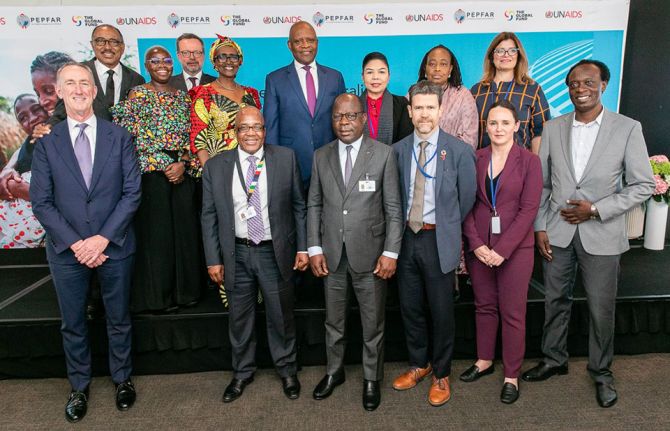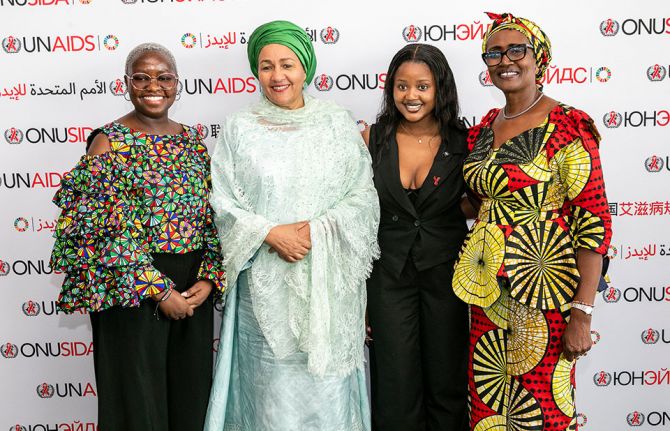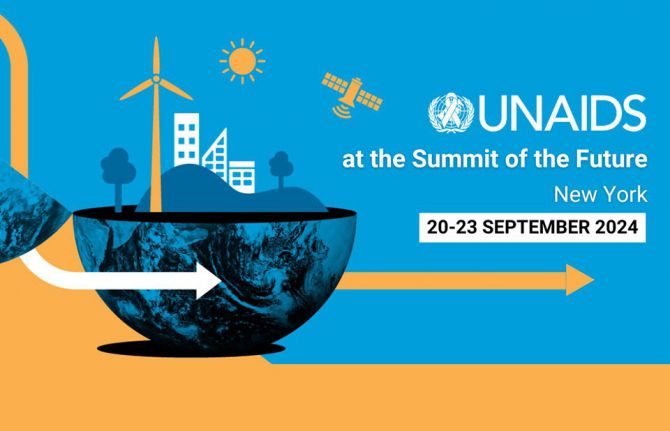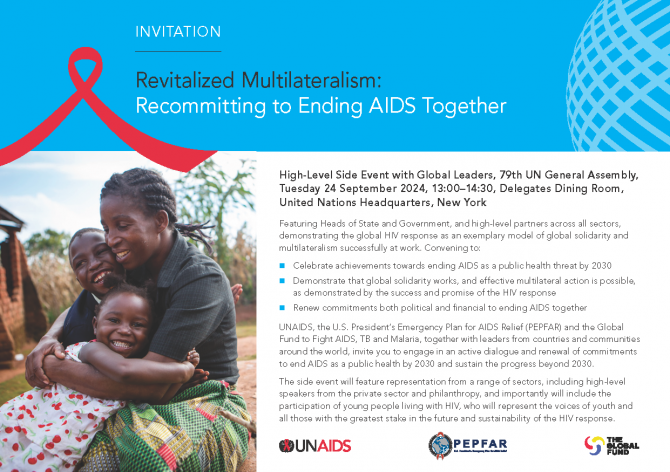


UNAIDS took part in the Summit of the Future and the 79th United Nations General Assembly in September. At a time when the progress on the Sustainable Development Goals needs to be urgently accelerated and global cooperation needs to be reinvigorated, the AIDS movement provides both a beacon of hope and a source of practical solutions on effective ways to tackle common challenges.
With 2030 just six years away, the sustainable development goal of ending the AIDS pandemic as a public health threat by 2030 is in sight. Leaders and stakeholders from across the world came together to recommit to the HIV response and its historic effort.
On 24 September, UNAIDS co-hosted a high-level side event, titled Revitalized Multilateralism: Recommitting to ending AIDS together. While celebrating the extraordinary successes achieved in the HIV response, UNAIDS highlighted that progress in the AIDS response cannot be taken for granted. Continued political and financial commitment is essential to meet the 2030 targets and sustain the gains made. UNAIDS also shared how strong collaboration, protection of civic space, adherence to the Universal Declaration of Human Rights, and promotion of inclusivity can lead to a more sustainable, fairer, and healthier world. The event provided an opportunity for Heads of State and Government and partners to renew their commitment to ending AIDS as a public health threat by 2030 through concrete actions. It showcased the successes and challenges of the HIV response and the key steps and approaches that countries are taking to accelerate progress towards reaching their 2025 targets and the 2030 goal and demonstrate how progress on tackling HIV helps power progress in the achievement of all the Sustainable Development Goals. The event culminated with steps taken to accelerate the HIV response, strengthen international and domestic financing for HIV and health, and sustaining the gains into the future.
Central to the HIV response is the power of affected people. Young people play an especially important role in driving positive change. To help ensure that young people’s voices are heard, UNAIDS organised the involvement in these global meetings of two inspirational young community leaders living with HIV, Jerop Limo from Kenya and Nomonde Ngema from South Africa. They reminded leaders of the importance of community-led approaches and of putting people first.


The world is at a crossroads. Leaders can achieve the revitalisation of multilateralism with people at the centre, can meet the Sustainable Development Goals and can ensure a safe, sustainable and fair world for all. The AIDS movement is at the Summit of the Future to help show how.
As the world convenes for the Summit of the Future at the United Nations General Assembly (UNGA) in September, leaders have the opportunity to transform the prospects of humanity by reinvigorating multilateral cooperation.
At a moment when the world is off track on meeting its shared goals, and when cooperation is fraying, the HIV response provides a beacon of hope and a source of practical solutions on effective ways to tackle common challenges. It has from a once a seemingly insurmountable crisis achieved extraordinary progress through people-centered multilateral cooperation. That over 30 million people living with HIV now have access to
life-saving treatment, and that the end of AIDS as a public health threat could be realised this decade stands as amongst the greatest public health successes of our time. They demonstrate what is possible when we work together, let science guide our actions, invest adequately, protect everyone’s rights, address inequalities, and empower communities to lead. The policies and systems that help advance the end of AIDS also serve to power progress on all the Sustainable Development Goals and to secure a safer, fairer world for all. The AIDS movement is an extraordinary asset to help the world move from crisis to constructive cooperation.
Strengthening people-centered cooperation is also vital to ensure that the gains made in the AIDS response are sustained. Progress, while monumental, is not universal.
Inequalities in access to prevention, treatment, and care persist. We still need urgent action to prevent the 1.3 million new infections every year. The epidemic is worsening in several countries, with three regions—the Middle East and North Africa, Latin America, and Eastern Europe and Central Asia—experiencing increases in new cases. Prevention technologies like PrEP are not reaching those who need them most, and stigma and discrimination continue to be significant barriers to accessing HIV treatment and care. A funding gap is holding back the HIV response in low- and middle-income countries.
A huge prize is in sight: by addressing the inequalities holding back progress in HIV, and accelerating HIV prevention and treatment efforts, we can ensure the end of AIDS as a public health threat by 2030, and the sustaining of this achievement for the future. What we need now is the courage and collaboration from global leaders to make the bold choices that will save millions of lives, overcome the deadliest pandemic, and ensure that tens of millions of people living with HIV can lead long and fulfilling lives.
By making serious investments, enacting necessary policy reforms, and working in partnership with each other and with civil society, world leaders can end AIDS as a public health threat and advance progress on all the Sustainable Development Goals.
The power of multilateralism in the global HIV response
- The global response to the HIV and AIDS epidemic stands as a multilateral success story.
- Multilateralism encourages innovative partnerships between governments, civil society, private sector, and academia, bringing diverse perspectives and expertise to tackle complex challenges in the HIV response.
- The Joint United Nations Programme on HIV and AIDS (UNAIDS) exemplifies this multilateral approach. Its unique partnership within the UN combines the expertise and resources of 11 Cosponsoring organizations and the Secretariat to lead the global fight against AIDS. This collaboration helps countries follow proven strategies and make progress together, all while upholding human rights.
- Easier accessibility to HIV and AIDS treatment, increased equity in health systems and improved access to education and health care — including improved prevention, testing and treatment services — have averted almost 20.8 million HIV and AIDS-related deaths over the past three decades.
- Through the Joint UN Programme on HIV and AIDS, nearly 30 million people worldwide are receiving HIV treatment and living healthy lives. Despite the lack of a vaccine or cure, efforts are ongoing to extend treatment to an additional 10 million people, demonstrating the success of international cooperation and evidence-based approaches in combating AIDS.
Taking a sustainable HIV response to 2030 and beyond
- Even when the world succeeds in ending AIDS as a public health threat, or achieving “disease control”, the pandemic will be far from over.
- While ending AIDS as a public health threat is within our reach—with the knowledge, tools, and pathways already established—the work does not stop there. As the global context evolves, we must stay vigilant and continuously adapt our strategies to ensure that people living with or affected by HIV can lead long and healthy lives.
- Planning for long-term sustainability beyond 2030 is crucial to preserving the gains made in the HIV response and ensuring that the impact is durable and transformative.
- The sustainability of the HIV response relies on country-driven and owned processes that leverage specific data and local contexts. Through the development of HIV Response Sustainability Roadmaps, countries can chart pathways to maintain and expand their progress, tailored to their unique circumstances.
- To achieve long-term sustainability, States need to prioritize integrating the HIV response into national health systems in ways which ensure that key and vulnerable populations are adequately supported. This transformation will enhance efficiency, promote equity, and strengthen human rights-based, people-centered health system
Prioritizing the mobilization of finance for a fairer HIV response
- As the world struggles to achieve many of the health goals set out in the United Nations Sustainable Development Agenda, investments in the HIV response have returned extraordinary gains for humanity. Since 2010, AIDS-related deaths have declined by 51% globally, and new HIV infections have fallen by 38%.
- But over 9 million people are still waiting for HIV medication that could save their lives, and there were 1.3 million new HIV infections in 2023. Increased investment is crucial to reach everyone who needs treatment and to prevent new infections that will drive up future treatment costs.
- The HIV response in low- and middle-income countries is hindered by a widening funding gap. In 2023, US$ 19.8 billion was available for HIV programs, but this was nearly US$ 9.5 billion short of the amount needed by 2025.
- In many countries with the most serious HIV pandemics, debt service consumes a large share of government revenue and limits public spending. In Angola, Kenya, Malawi, Rwanda, Uganda, and Zambia, debt service obligations exceed 50% of government revenues. Last year, Sierra Leone spent 15 times more on public debt servicing than on health, 7 times more than on education, and 37 times more than on social protection.
- Reforming the global financial system is essential. This includes debt cancellation, implementing fairer and more affordable financing mechanisms, and global taxation reform. Such changes are necessary to releasing transformative funding for health, education and social protection also required to end AIDS as a public health threat by 2030.
- Global financial leaders must reject calls for more fiscal restraint and embrace measures that can release the necessary investments to save millions of people and transform the lives of the most vulnerable all over the world.
- States need not only to address the immediate financial shortfalls but also develop long-term strategies to secure sustainable funding for the HIV response. This includes enhancing domestic revenue generation and reducing reliance on external aid to ensure lasting impact beyond 2030.
Upholding Human rights is key to ending AIDS
- There is no sustainable response to HIV without human rights. If we ignore these principles, we'll face a much longer timeline and greater costs in terms of both money and lives.
- The fight against AIDS is increasingly challenged by growing anti-rights and anti-gender rhetoric and policies. The latest Global AIDS Update report shows that these trends block effective HIV prevention, treatment, and care. We must reverse these negative trends to keep our progress on track to end AIDS by 2030.
- Upholding human rights involves advancing gender equality, as gender-based violence and inequality significantly contribute to the spread of HIV and hinder access to prevention and treatment services.
- The UN’s Universal Declaration of Human Rights reminds us that all rights are interconnected. To effectively tackle HIV, we must protect all rights, including access to healthcare, education, freedom of expression, and the right to participate in public life. When these rights are undermined, countries often face setbacks in both democracy and public health.
- Countries that uphold human rights make better progress in fighting AIDS.
- All States have an obligation to guarantee the rights of all people. No form of discrimination is acceptable. There is no justification for denying any person’s human rights based on their sexual orientation or gender identity.
- States need to enact swift and transformative measures to end restrictive and discriminatory laws, policies and practices, and protect the human rights of their populations.



